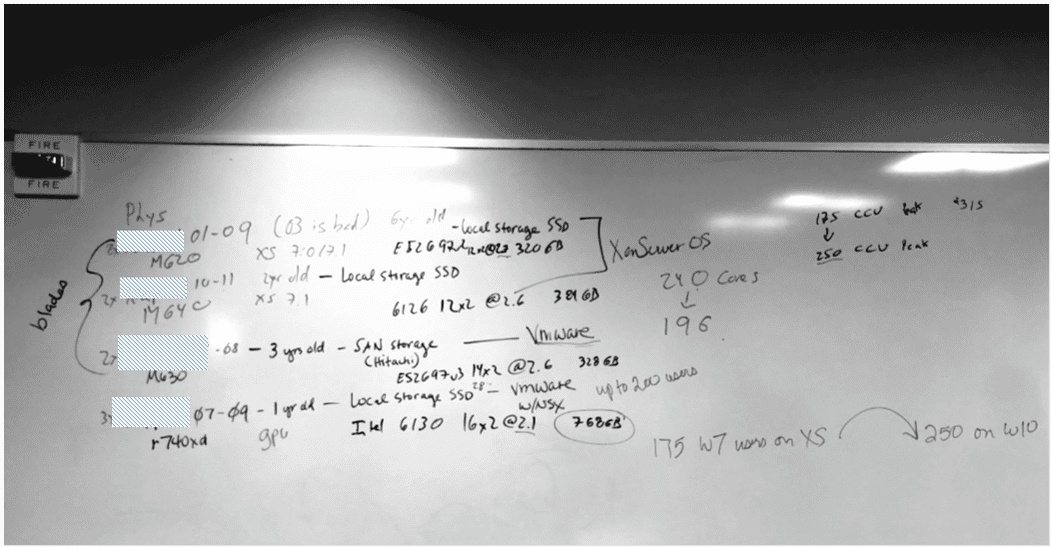No less than 12 times over the last 18 months we have seen the following VDI disaster strike unsuspecting companies.
One article telling others to beware won’t make a difference in the big scheme of things. But if this cautionary tale can save just one of you potential victims, that would be a worth the e-ink I am burning this very second.
The scenario goes something like this:
Using the VDI Calculator: When it’s time to go all-in on Virtual Desktop (VDI)
A company decides to go with VDI, virtual desktops, VMware End User Computing, published applications, or whatever you want to call it. A bell rings and a VMware / Citrix expert gets their wings. The people rejoice. (Not really, but it seemed to fit).
To go VDI, the company needs new hardware or at least a hardware refresh. If they have not bought into the religion of one particular brand (Dell, HP, Nutanix, SuperMicro, Lenovo, etc.) they ring up their local <insert major brand name> sales person and begin working through the sizing parameters for the equipment they’ll need to successfully deliver an amazing VDI user experience.
In many cases the sales representatives and pre-sales engineering teams they work with have no firsthand experience sizing hardware for VDI environments. If they have specced VDI environments in the past, it’s only been a handful of times. So they take their cues from sizing documents found via Google, or sizing calculators on supporting vendor websites. Marks to Nutanix here for having one of the nicer calculators.
Sizing a VDI environment is not something you should trust to a vendor VDI calculator. The math (example above) should be the reality check. The variables of your environment, applications, existing hardware, storage, workflows need to factored in first. And even this math reality check should be verified by a small pilot project before any significant money is spent.
Overestimating users per host; underestimating overhead
This is typically where a company realizes they lack the expertise to pull this off internally and reach out to Whitehat. Most have already purchased the hardware on the back of the vendor’s recommendation; some have not. The next step is the same for both: VDI sizing math.
It is during this review of the proposed configuration(s) for the VDI hosts and the subsequent math that the first signs of trouble usually appear.
Some major hardware vendors are still building off 2008 VDI sizing guides. Some do not take the added overhead of Windows 10 into account. Some confuse published application and VDI configurations, wildly overestimating the number of users the customer will get per host. And, beyond simple estimates on the number of Task Workers, Knowledge Workers and Power Users, not a lot is done to dig into the customer use cases, workflows, application set or application behavior.
Looking for a shortcut? Download our guide:
The result typically goes something like this: (Real dialog)
“We’ve already spent the VDI hardware budget”
“Alright, completing the math based on your user count, available RAM, CPU sockets and cores, NICs, OS, application set and use case, you will get a density of 45 users per host server. Of course, we will validate this with a proper test.”
“X Vendor said we could get 122 users on each of these hosts!”
“Well, you can see the math, the reality is with this purchased processor, the core counts etc. the density is going to be 1/3 of that. Replacing these with X processor with more cores will help, adding more RAM will not improve the situation. The NIC cards are not on the hardware compatibility list with the hypervisor you have selected, you will want to change those to X brand to avoid problems or look at an alternative hypervisor.”
“We can’t do any of that. We already spent the budget. We are going to have to make this work.”
“Have you considered adding NVIDIA GRID GPU? This will offload a fair amount of work from the CPUs and give the end users a more PC-like experience. We can get a couple of test cards in if you want to validate it.”
“That sounds good. We can try that to see if it will help.”
“Wait, the hosts you purchased are not on capable of accepting GPU cards.”
“Yes, that is right, our vendor told us GPU was only really needed for AutoCAD and stuff like that, we would not need it, so he switched us to a more popular, less expensive host configuration.”
“OK, with the hardware in place, understanding there will be some minor adjustments, the density will cover 1/3 of the users you wanted on VDI."
“That is not good, I am not sure I believe that. X Vendor said it would work. I think they probably know more than you. I bet we will see better density numbers when we actually get this built.”
When VDI reality bites
Flash forward a few weeks. Real-life density matches the math plus or minus a user, and a sinking feeling sets in for the company that the VDI workspace objective cannot be achieved with the equipment in the room and budget spent.
This company is going to have to wait a year to finish this project and put up with a less than optimal solution in the meantime. Some amount of productivity dollars x every employee x 12 months is going to follow those spent budget dollars right out the door.
10 tips for avoiding VDI hell
Here’s how all of this can and should be avoided.
1. Do NOT accept that the hardware vendor’s sizing document is accurate enough to use to place an order without first…. Nope, just don’t do it.
2. Get the implementation team AND support team involved before the budget dollars are spent. If no one in this group has extensive experience deploying Citrix Apps, Citrix Desktops or VMware Horizon, stop and go find that expertise. Look for a Citrix or VMware Horizon expert that does dozens of VDI-related projects each year. One that does hundreds is even better.
3. It would be ideal to talk to a firm that supports VMware and Citrix environments every day. We changed our approach to building out VMware and Citrix environments once we understood the challenges that come with making them perform well every day.
4. Do not dismiss printers, scanners, signature pads, and other peripheral devices. Whoever is doing the build needs to understand what devices the employees will need to interact with, which ones will work, which ones are supported by Citrix, VMware, etc. and which ones are not. These are the devices employees will use daily, take the time to make sure they are solid and reliable.
5. Work through a Proof of Concept and Production Pilot if necessary. But do it before the budget is spent. That will ensure there is a clear understanding of how all the components are going to come together to deliver the right end user experience.
6. DO NOT buy third-party tools at this stage of the game without trying them first or understanding what the learning curve is going to be like for the IT staff to fully grasp how to become experts with them. If you have a firm managing your environment, they should provide the tooling as part of their fee.
7. Make sure you do the math. Buying a bunch of stuff and paying someone to slam it all together before you have any real idea if the result is going to deliver the right experience almost always leads to disappointment. On occasion it ends in having paid way too much and bought way too much to solve the problem.
8. Consider and understand what the future state support model will look like. VDI should deliver a great end user experience. It also should, without qualification, deliver significant support time savings for the IT department. No, you are not likely to let anyone go, but you should expect to be able to leverage IT capacity that you’ve freed-up for the benefit of the organization. If you don’t end up with significant support time savings, something is broken and needs fixing.
9. If having Citrix or VMware onsite is important, or if Citrix Cloud impractical, look at black box Citrix or VMware Horizon appliances that guarantee and/or warranty the end user experience so you can completely avoid the risk of under sizing your hardware.
10. While not specifically related to the initial build, determine who your Citrix expert is going to be. The same is true for VMware. You will need a VMware Horizon expert. Someone who can truly learn the technology and the thought process that makes it sing. If it does not make sense to grow a VDI expert and you can’t afford to hire one, then outsource to a VDI expert (like Whitehat). Again, without the right talent at the wheel helping you extract the value out of a Citrix or VMware VDI environment, the experience is going to be less than it could have been.







Leave Comment